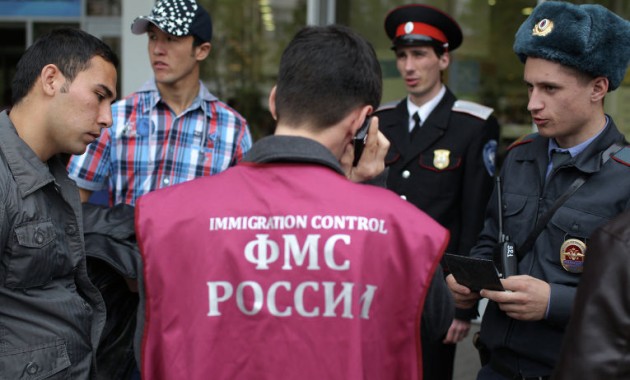
Uncontrolled Movements of People in North Caucasus Threaten Russian Security
Publication: Eurasia Daily Monitor Volume: 12 Issue: 219
By:

The Russian authorities have lost control over three key movements of people in the North Caucasus—from rural areas to the cities, from the North Caucasus region to Moscow and other Russian centers, and from the region to Syria and the Middle East more generally. That has reduced the government’s ability to counter nationalist and Islamist movements in order to ensure security on the country’s southern borderlands.
In Soviet times, the registration (propiska) system in almost all cases meant that people could not move without the approval of the authorities, which rooted rural residents in their villages, precluded the movement of Russians and non-Russians from the borderlands to Moscow and other major Russian cities, and prevented any flow at all of people from the borderlands into neighboring countries. All three of these things are now occurring at an ever-increasing rate, and that is posing a severe security challenge for the authorities, one that some of them acknowledge they are not now meeting.
The movement from rural areas to the cities within the North Caucasus, although the least noted of the three, is profoundly affecting Russian security in a double way. On the one hand, young people who move from auls and villages to larger cities can become disconnected from their traditional ethnic communities and are then easily mobilized by radical Islamists. And on the other hand, the increasingly large portions of rural areas in the region where there are almost no indigenous residents left give radicals space to operate and leave the authorities with few allies to monitor the situation. In highland Dagestan, for example, ever more auls are emptying out, and both they and the surrounding countryside are now operational centers of radical nationalists and Islamists (Kavpolit.com, November 30).
Migration from the North Caucasus region to Moscow or other parts of the Russian Federation is having three consequences, all of which are making it more difficult for the regime to control the situation. First, as a result of ethnic-Russian flight and the departure of minority ethnic groups within the republics, each of the republics of the North Caucasus has become more mono-ethnic than at any point in their history. That limits Moscow’s ability to use ethnic Russians as “a buffer” between other groups, something that paradoxically increases the likelihood of interethnic conflicts because any remaining minorities or new minorities in neighboring Russian areas can become targets (Kavpolit.com, November 30).
According to official statistics, only about one in every eight of these migrants—and this measure includes people from the neighboring countries of Azerbaijan, Armenia and Georgia as well—is officially registered, with the remainder, nearly a million in all, existing in a gray zone where criminality and extremism flourish. And according to regional expert Anton Chablin, these flows have become “ever less controlled,” thus pointing to ever more problems ahead.
That problem is exacerbated by another: the flow of guest workers from the North Caucasus who experience Russian animosity to “persons of Caucasian nationality.” These individuals can become radicalized, not only in Russia but even more when they return home and have the chance to interact with others who have had the same unfortunate experiences. As the Russian economic situation has worsened, they are coming back angry, often without having been paid at the end—and they too constitute a serious migration challenge that the authorities do not yet have a handle on.
A special set of problems arises with those who were forced to resettle during the conflicts of the 1990s and who have been unable to return home. Not only are they increasingly radical, but their children who have grown up in such situations are increasingly radical as well, often seeing Islamist slogans as more attractive than the nationalist ones that have so far failed their parents.
Taken together, the number of all migrants in the North Caucasus is enormous: Although the region constitutes only about 9 percent of Russia’s population, the region includes nearly a third of the 3.5 million migrants that Moscow counts—and both the number in the North Caucasus and the number for Russia as a whole are certainly far larger.
But it is the third “migration” flow that is generating the most immediate concern. It involves those who have gone to Syria or elsewhere in the Middle East to fight for the Islamic State or other radical groups and who are then returning home, where they will continue their fight or recruit others. Russian officials, from President Vladimir Putin on down, suggest that there are only a few thousand of these, but regional experts say that Moscow is understating the problem by a factor of at least ten. The Kremlin says there are only 500 Dagestanis in the ranks of the Islamic State; whereas, local experts say the figure is 5,000 or even more (Onkavkaz.com, December 7).
While there is evidence that the Federal Security Service (FSB) is only too happy to see North Caucasian radicals leave Russia and go to Syria, it is increasingly becoming clear that many of those who fight for the Islamic State there are coming home to fight for it inside the borders of the Russian Federation. Moreover, it appears that the Russian officials not only do not know how many such people there are but also have not yet figured out a good strategy to cope with them (Kavkazoved.info, December 2).
Some Russian security commanders advocate the use of draconian force. However, Moscow is learning that in today’s straitened economic times, with unemployment especially high and wages especially low in the North Caucasus, each counterterrorist operation is proving counterproductive, driving more North Caucasians into the arms of the radicals rather than breaking their will. Until that changes, migration and the inability of Moscow to control it will work against Russian national security.




